MacIntosh Forts
The MacIntosh Forts are a group of seven observation posts built in Hong Kong between 1949 and 1953 at the border with China, to safeguard the border against illegal immigrants, when there was an influx of refugees from China due to political instability.[1] The Forts were named after Hong Kong Police Commissioner Duncan William MacIntosh (in office, 1946-1953) who decided to build a chain of observation posts guarded day and night. They have been listed as Grade II historic buildings since 1997.[2]
| MacIntosh Forts | |||||||||||||
|---|---|---|---|---|---|---|---|---|---|---|---|---|---|
| Traditional Chinese | 麥景陶碉堡 | ||||||||||||
| |||||||||||||
Description
The MacIntosh Forts were built along the Sham Chun River when an influx of Chinese refugees was followed by border incidents of armed clashes between the police and refugees.[2] Amongst the refugees were the defeated remnants of the Kuomintang Nationalist armies and also a "fair number of common criminals".[3] The Forts were built in reinforced concrete of the same style and of very similar design, which may be categorised as Modern Utilitarian.[2] Built on hilltops at strategic spots, with a view across the border, they were dubbed the Macintosh Cathedrals because of their distinctive appearance and outline against the skyline.[3] Six out of the seven Forts are now remotely controlled.[1] They are not open to public.[4]
List
The seven observation posts are located in a chain, covering most parts of the land frontier. They are from east to west:
| Location | Notes/References | Photographs |
|---|---|---|
| Pak Kung Au (伯公坳), Sha Tau Kok, North District | The second highest among the 7 Forts, with 722 steps to reach it.[2] | 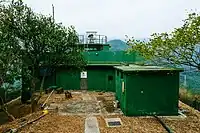 |
| Kong Shan (礦山), Lin Ma Hang, North District | The highest among the 7 Forts, with 917 steps leading up to it. It cannot be controlled remotely and a police constable is still deployed on it every night.[2] Its elevation is over 700 feet above sea level.[3] | 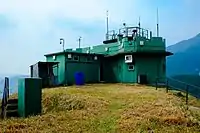 |
| Pak Fu Shan (白虎山), Lin Ma Hang, North District | This fort, together with three nearby pillboxes and the Pak Fa Shan Operation Base (Ta Kwu Ling Division), formed part of the border defence system.[2] | 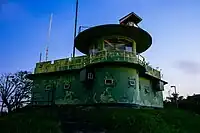 |
| Nga Yiu (瓦窰), Ta Kwu Ling, North District | It is located near Lo Shue Ling.[1] | 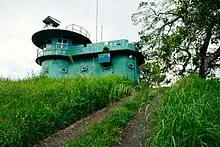 |
| Nam Hang (南坑), Ta Kwu Ling, North District | It is located near Lo Wu.[1] | 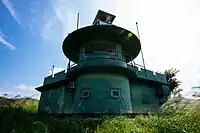 |
| Ma Tso Lung (馬草壟), Lok Ma Chau, North District | One of the two forts not located within the Frontier Closed Area. It is near to Ma Tso Lung. | 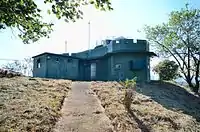 |
| Pak Hok Chau (白鶴洲), Mai Po, Yuen Long District | One of the two forts not located within the Frontier Closed Area. It is near to Mai Po Nature Reserve[2] and has played an important role in intercepting illegal immigrants coming from the Deep Bay.[1] | 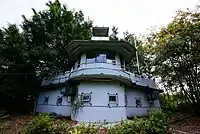 |
Photo Gallery
Other photos of the forts
 Sign for the MacIntosh Fort at Kong Shan, Lin Ma Hang
Sign for the MacIntosh Fort at Kong Shan, Lin Ma Hang MacIntosh Fort at Kong Shan, Lin Ma Hang overlooking Shenzhen
MacIntosh Fort at Kong Shan, Lin Ma Hang overlooking Shenzhen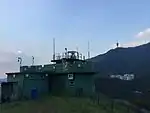 MacIntosh Fort at Kong Shan
MacIntosh Fort at Kong Shan.jpg.webp) MacIntosh Fort at Pak Kung Au
MacIntosh Fort at Pak Kung Au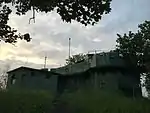 MacIntosh Fort at Ma Tso Lung
MacIntosh Fort at Ma Tso Lung
References
- Antiquities and Monuments Office: Introduction to 1444 Historic Buildings
- Brief Information on Proposed Grade II Items Archived 2013-02-23 at the Wayback Machine
- R.G. Horsnall, "The MacIntosh Cathedrals", in Journal of the Royal Asiatic Society Hong Kong Branch, Vol. 35, 1995, pp. 171-176
- Legislative Council - Official Record of Proceedings, 6 December 2006, p. 101
External links
- Tse, Ching-kan Curry (October 2006). The Fortified Line: Police Observation Posts in the Frontier Closed Area at the Border of Hong Kong and Shenzhen (PDF) (M.Sc. in Conservation thesis). The University of Hong Kong. Archived from the original (PDF) on 5 April 2015. Retrieved 27 March 2015.
- Survey on Features with Cultural Heritage Value in the Sha Tau Kok, Ta Kwu Ling and Ma Tso Lung Areas, 17 December 2007 (with maps showing the location of the Forts)